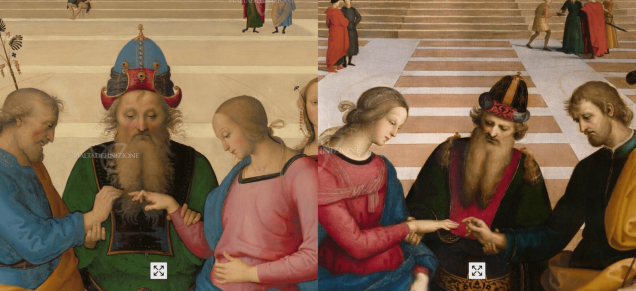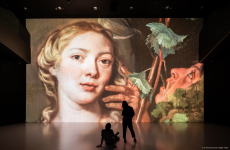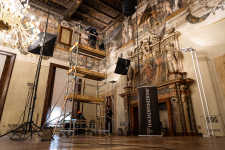The episode of the marriage of Mary and Joseph was a popular subject for Renaissance painters, and the two finest versions of it are by Perugino and Raphael, from 1503 and 1504, respectively.
These two versions are similar in many respects, and there are comparative analyses of them in art history textbooks from middle school to university level. Today Haltadefinizione’s new comparative viewer makes a new dialog between them possible. It is built to give the user a comparison of the two images in ultra-high definition. This comes at the end of the celebrations of the 500th anniversary of Perugino’s death and represents a unique opportunity to immerse yourself in the nuances, the differences and similarities between the two masterpieces.
The Gigapixel Digitizations
The basis of the comparative viewer is the ultra-high definition Gigapixel digital acquisition of the two pantings by Raphael and Perugino. Haltadefinizione did this work during two separate digitization projects in 2020 and 2023.
In 2020, Haltadefinizione conducted ultra-high definition and 3D digital photgraphy at the Pinacoteca di Brera of Raphael’s version, after its 2009 restoration. The 2020 project took place on the occasion of the fifth centenary of Raphael’s death.
At the beginning of 2023, Haltadefinizione specialists completed the Gigapixel digitization of Perugino’s Marriage at the Musée Des Beaux-Arts in Caen, France. This project was done on the occasion of the work’s return to Italy for the great celebratory exhibition at the National Gallery of Umbria on the 500th anniversary of Perugino’s death.

These two productions have led to the publication of two ultra-high definition images in Haltadefinizione’s online Image Bank. This offers art experts and enthusiasts an unprecedented opportunity to zoom in on details and nuances in ultra-high resolution.
Exploring Details with the Comparative Viewer
Despite the close thematic connection and the close personal relations between the two masters, only once in history have the two Marriages been physically close to each other. In 2016, the Pinacoteca di Brera hosted the Marriage of the Virgin by Perugino from Caen for an extraordinary comparison with the painting of the same subject by Raphael. The two were seen side-by-side during the exhibition Primo dialogo, Raffaello e Perugino attorno a due Sposalizi della Vergine.

The comparative viewer developed by Haltadefinizione puts this extraordinary comparison on permanent display. Anyone can easily examine every detail of the two versions of the Marriage painted by Raphael and Perugino. The subtle differences, the artistic choices and the distinctive elements present in the two versions of the same subject, are on full display, for a deeper understanding of this extraordinary dialog between the two artists.
Thanks to the unique path of exploration made possible with Gigapixel images from Haltadefinizione, we all can inspect every detail and grasp the stylistic, thematic and narrative differences between the two paintings as never before.
Now let’s look at some details from the two versions of the Marriage of the Virgin. This will show that, in general, Raphael’s is more lively and naturalistic, while Perugino’s is more idealized. In the following images, as in the online comparative viewer, Perugino is on the left and Raphael is on the right.
The ring

While in Perugino’s work the ring is invisible, hidden in Joseph’s hands, in Raphael’s version the ring is shown clearly. This highlights their different approaches. Raphael’s realism devotes more attention to detail and naturalistic rendering, as opposed Perugino’s more subtle and idealized view.
The temple

There are big differences in the two architectural representations of the temple. Raphael has chosen a centralized design, which gives the scene a sense of clarity and space that invites the gaze to move freely. Perugino’s octagonal temple gives a more flattened and static feeling to the whole. Raphael’s choice to emphasize the temple gives depth and dynamism to the scene, while Perugino’s more static approach makes the environment less suggestive in terms of perspective.
The priest

The officiant plays a central role in each of the two versions of the Marriage of the Virgin, by Raphael and Perugino. In Perugino’s version, the priest appears static, being positioned in the center in a stiff and symmetrical pose. In Raphael’s, he is bending to his left side, which makes the scene more dynamic. Also, Raphael’s rendering of the face and the figure shows more naturalistic details, such as the carefully painted beard and facial expressions. His shadows and the complexion are more precise and natural than Perugino’s, and they demonstrate Raphael’s mastery in creating a more vivid representation.
The boy breaking a stick

In the both versions, there is a reference to an old story in the figure of the boy breaking a stick. Raphael’s rendering of this figure is more credible, close to the style of a well-known Hellenistic statue called Boy with a Thorn (Spinario). On the contrary, in Perugino’s work, the historical reference appears less realistic and more of a fairy-tale rendering of the figure.
The position of the feet

Perugino chooses a more ethereal and almost dancing representation, where the protagonists' feet seem to rise slightly, lending an air of grace and lightness to the scene. On the contrary, in Raphael, the feet are more firmly and set on the ground in a more realistic approach, which allows a feeling of stability and solidity to emerge.

Faces and Hats

Perugino’s figures show his attention to the stylization of facial features, and to the greater ornamentation and detail in the decoration of hats. On the other hand, Raphael takes a more natural approach. His complexions and facial colors are more realistic, such as in the details of the hair, which is painted in more precise detail than in Perugino’s version. This difference highlights Raphael’s taste for more accurate rendering of anatomical details.

Landscape and small figures in the right background

There is a notable difference in the rendering of the landscape and the small characters in the background, particularly on the right side of the two compositions. Perugino is distinguished by the clarity and precision of both the characters and the landscape. On the other hand, Raphael’s landscape is more nuanced and less clear.
Explore these and other interpretations of The Marriage of the Virgin, digitized in ultra-high definition, in Haltadefinizione’s Image Bank.




